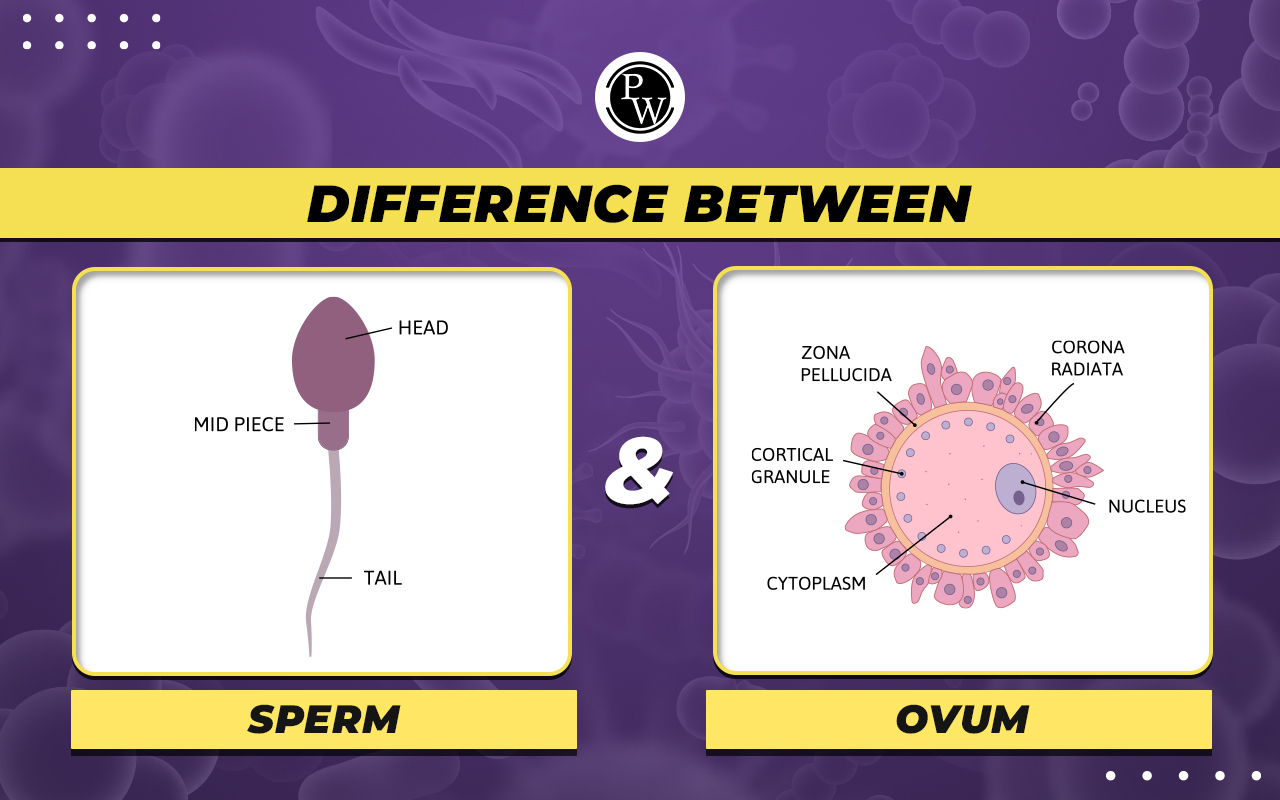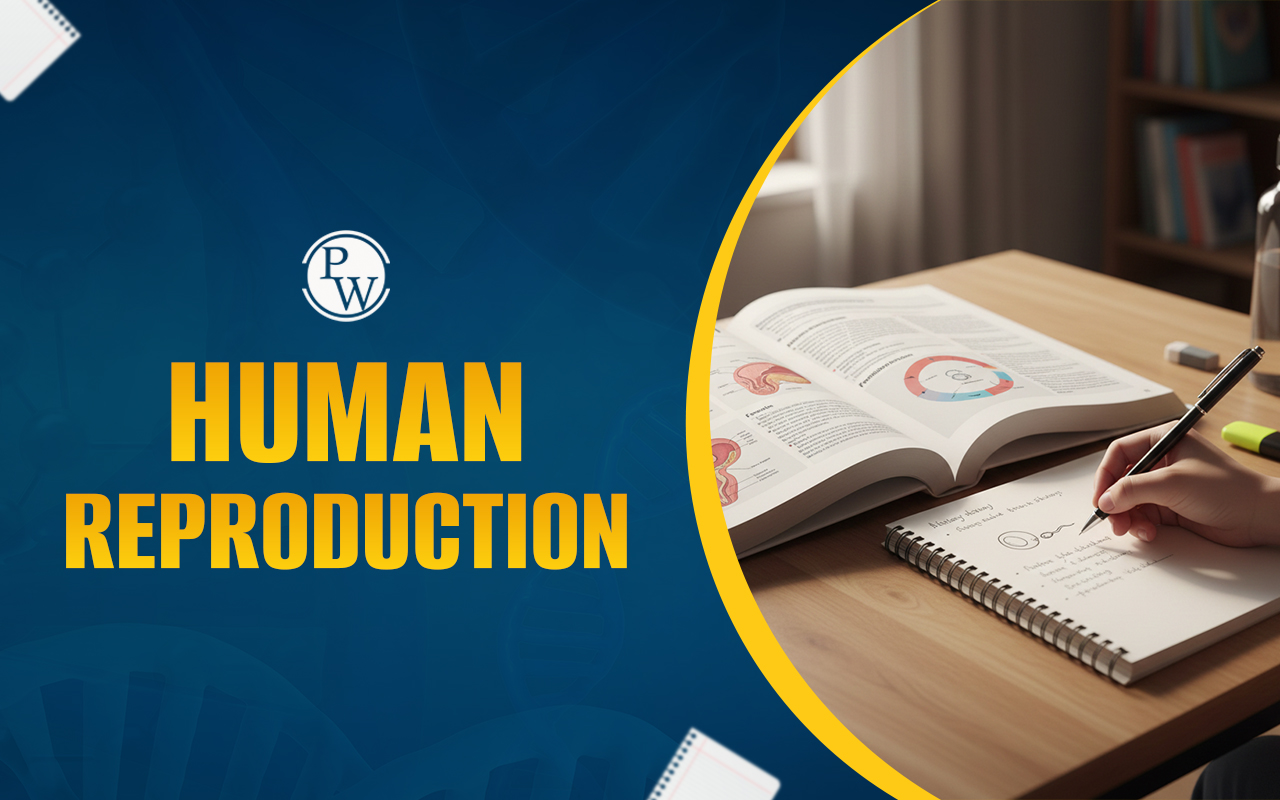

Difference Between Sperm and Ovum: Sexual reproduction requires two fundamental components: sperm and ovum. Sperm is the male reproductive cell, whereas the ovum is the female reproductive cell. These two cells differ significantly in terms of their properties and activities, and knowing their distinctions is important to understanding the sexual reproduction process. Read the article to get details about the difference between Sperm and Ovum.
| NEET Biology Syllabus | NEET Biology Diagrams |
| NEET Biology MCQ | NEET Biology Chapter wise Weightage |
| NEET Biology Notes | NEET Previous Year Question papers |
Difference Between Sperm and Ovum Overview
The ovary of a female produces the ovum, a female cell. The testis produces sperm, which is a male cell. Sperm cells are the tiniest cells in the male body. The ovum, commonly known as an egg cell, is the most considerable cell in the female body. The male gamete is a motile, long, flagellated cell divided into four parts: the head, neck, middle, and tail. The cytoplasm is abundant. The plasma membrane surrounds sperm. The nucleus includes X or Y chromosomes. The female gamete, whose cells are spherical spheres and non-motile, but not divided into distinct areas. Cytoplasm is found in modest levels. Ovum is found in egg envelopes. The nucleus includes X chromosomes, which serve as sex chromosomes.Difference Between Sperm and Ovum
The two most essential cells in the reproductive system of humans are sperm and ovum, the former being a male reproductive cell and the second a female reproductive cell. These cells are responsible for fertilization by fusion and creating a zygote. The complete difference between sperm and ovum is given in the table below.| Difference between Sperm and Ovum | ||
|---|---|---|
| Basis | Sperm | Ovum |
| Definition | The sperm is a male reproductive cell or gamete. | The ovum is a female reproductive cell or gamete. |
| Size | It is small, typically measuring 50-100 micrometers. | It is large, typically measuring 100-150 micrometers. |
| Shape | It is long and narrow, with a tail-like structure. | It is spherical. |
| Genetic Material | It contains genetic material, or DNA, in the head. | It contains genetic material or DNA, in the nucleus |
| Protective Structure | It is protected by a cap-like structure called the acrosome. | It is surrounded by a protective layer called the zona pellucida. |
| Production Regulation | It is regulated by hormones released by the hypothalamus and pituitary glands in the brain. | It is released cyclically due to hormonal changes in the body. |
Sperm
Sperm is a male gamete or reproductive cell essential to human and animal reproduction. Animals generate motile sperm cells with a tail, known as a flagellum, and these are termed spermatozoa. On the other hand, non-motile sperm cells, known as spermatia, are produced by algae and fungi. Certain plants, including ferns and gymnosperms, have motile sperm, whereas the blooming group has non-motile sperm inside the pollen. The 23 chromosomes of a human sperm cell, which is haploid, combine with the 23 chromosomes of an ovum, or female egg, to generate a diploid cell.Ovum
The ovum is a reproductive cell. It is found in most animals, including humans, and is also known as an egg cell or, in the plural, an ova. The ovum is not mobile; during fertilization, it fuses with the sperm to produce a zygote, or diploid cell, which has the potential to develop into a new creature. An animal's immature ovum is referred to as an ovule. Mammals are born with many ova, which develop during oogenesis. All animals, including humans, have internal fertilization of the ovum. Without a microscope, it is visible to the unaided eye and is among the biggest cells in the human body. In humans, it has a diameter of around 0.1 mm. The core of an ovum contains a substance known as the yolk or ooplasm.Difference Between Sperm and Ovum FAQs
What is the difference between sperm and ovum?
Sperm is the male gamete produced in the testis, while the ovum is the female gamete produced in the ovary. The ovum, also known as the egg cell, is the most considerable cell in the female body, whereas the sperm is the smallest cell in the male body.
Is the sperm the baby or the egg?
Conception happens when a sperm penetrates the egg, creating a zygote. The zygote holds all the DNA required for a baby, half from the mother's egg and half from the father's sperm.
Is all male sperm female?
The male can produce two types of sperm: one carrying the X chromosome and the other the Y chromosome. If the egg receives an X chromosome, the individual is female (XX); if it gets a Y chromosome, it is male (XY).
How does sperm develop?
Sperm development occurs in the testicles within tiny tubes called seminiferous tubules. At birth, these tubules contain simple round cells, which transform into sperm cells during puberty under testosterone and other hormones.
How big is a woman's egg?
The human egg, or ovum, is one of the largest cells in the human body, measuring approximately 0.12 mm in diameter. You would need nine eggs to reach a millimeter in length; if laid side by side, 100 eggs would form a line 12 mm (1.2 cm) long.
🔥 Trending Blogs
Talk to a counsellorHave doubts? Our support team will be happy to assist you!

Check out these Related Articles
Free Learning Resources
PW Books
Notes (Class 10-12)
PW Study Materials
Notes (Class 6-9)
Ncert Solutions
Govt Exams
Class 6th to 12th Online Courses
Govt Job Exams Courses
UPSC Coaching
Defence Exam Coaching
Gate Exam Coaching
Other Exams
Know about Physics Wallah
Physics Wallah is an Indian edtech platform that provides accessible & comprehensive learning experiences to students from Class 6th to postgraduate level. We also provide extensive NCERT solutions, sample paper, NEET, JEE Mains, BITSAT previous year papers & more such resources to students. Physics Wallah also caters to over 3.5 million registered students and over 78 lakh+ Youtube subscribers with 4.8 rating on its app.
We Stand Out because
We provide students with intensive courses with India’s qualified & experienced faculties & mentors. PW strives to make the learning experience comprehensive and accessible for students of all sections of society. We believe in empowering every single student who couldn't dream of a good career in engineering and medical field earlier.
Our Key Focus Areas
Physics Wallah's main focus is to make the learning experience as economical as possible for all students. With our affordable courses like Lakshya, Udaan and Arjuna and many others, we have been able to provide a platform for lakhs of aspirants. From providing Chemistry, Maths, Physics formula to giving e-books of eminent authors like RD Sharma, RS Aggarwal and Lakhmir Singh, PW focuses on every single student's need for preparation.
What Makes Us Different
Physics Wallah strives to develop a comprehensive pedagogical structure for students, where they get a state-of-the-art learning experience with study material and resources. Apart from catering students preparing for JEE Mains and NEET, PW also provides study material for each state board like Uttar Pradesh, Bihar, and others
Copyright © 2025 Physicswallah Limited All rights reserved.
Get App











